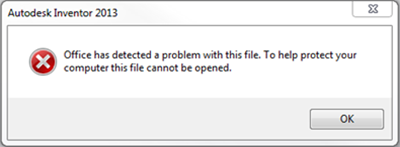When you go on to open a Microsoft Office file, you may have noticed that it is opened in Protected View. When files are opened in Protected View, you can read them, with minimal risks to your Windows computer. If Microsoft Office detects a problem with the file you will see the following message:
Office has detected a problem with this file, To help protect your computer this file cannot be opened. Editing it may harm your computer

You may receive such messages if the files contain macros, data connections, ActiveX controls, or even malware – and File Validation / Trust Center is detecting a problem with the file. It could be a malicious file or a damaged file. You may receive even receive such messages when you go on to open an embedded object, perform a mail merge or open a file from a viewer.
Office has detected a problem with this file
Files from the Internet and from other potentially unsafe locations may be malware. These agents may harm your computer. To help protect your computer, Microsoft Office opens files from such potentially unsafe locations in Protected View.

If you continue to receive such messages, you can change the default Trust Center settings to a less-safe macro security setting or even disable Protected View. But this is not recommended.
A better option would be to move such files to a Trusted Location. You can add trusted locations, in any Microsoft Office document like Access, Excel, Visio, Word, and PowerPoint
If you do this, Office files will not be checked by Trust Center or opened in Protected View. But remember – you have to be very sure that the new location is completely secure.
This post will show you how to add, remove, modify Trusted Locations in Office.
How do I fix Microsoft Office errors?
You may encounter different errors with Microsoft Office applications, like installation errors, errors related to the verification of Office license, different error codes, etc. Hence, you need to troubleshoot Office errors accordingly.
How do I turn off Protected View?
You can turn off the Protected View in Microsoft Office by opening any Office application, like Excel, Word, PowerPoint, etc. Open an Office application, say Word, and go to File > Options > Trust Center > Trust Center Settings. Select Protected View from the left side and then disable the Protected View.
That’s it. I hope this helps.
is it possible to use the Trusted Locations in Office in: C:usersUSERNAMEAppDataLocalTempSubfolder, using Office 2016, 32-bit?